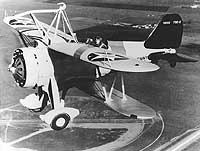
As a result of their dramatic operations with the Navy's short-lived airships Akron (ZRS-4) and Macon (ZRS-5), the Curtiss F9C biplane fighters gained fame all out of proportion to their small number. The type originated with a May 1930 specification for a small aircraft carrier-based fighter. The resulting XF9C-1 (Bureau of Aeronautics serial # 8731) was built under a June 1930 contract and delivered in March 1931. Tested over the next several months, it showed good performance but was not particularly suitable for carrier use. However, the plane did have one significant feature: it was the only available combat airplane small enough to fit through the hangar door of the dirigible Akron, which was then nearing completion. Accordingly, the XF9C-1 was modified with a "skyhook" that would allow launching and recovery from the airship's "trapeze" airplane handling device. The plane first "landed" on the older airship Los Angeles (ZR-3) in October 1931 and subsequently was actively employed in developmental operations with the Akron.
The XF9C-1's successful new role resulted in the construction of seven modified versions, the XF9C-2 (Bureau # 9264) which was a 1931 private Curtiss project that was purchased by the Navy in November 1932, and the production F9C-2s (#s 9056-9061). The latter were built under an October 1931 contract and were the only "Sparrowhawks" that were suitable for operational, as opposed to experimental, use. The first of these was flown in April 1932 and began work with Akron late June. Further modifications resulted and all six F9C-2s were in Navy hands by September 1932. These planes worked with Akron until her loss on 4 April 1933. They were then transferred to the heavier-than-air unit of Macon, which was nearing completion. From late 1933 until early 1935 they were vigorously employed in efforts to demonstrate the dirigible's value as a unit of the United States Fleet. Beginning in mid-1934 they generally had their wheeled landing gear replaced with a "teardrop" fuel tank whenever they were based on board Macon, thus considerably improving their endurance, an important element in extending the strategic scouting reach of the airship-airplane team.
Unfortunately, this aspect of Naval aviation history abruptly ended when Macon crashed at sea on 12 February 1935. Four F9C-2s were lost with her. The two survivors (#s 9056 and 9057) were subsequently used in Fleet utility work. F9C-2 # 9057 was disposed of in 1937, but # 9056 remained in Navy service until 1940, when it was transferred to the Smithsonian Institution for preservation as a museum artifact. The XF9C-1 was surveyed in 1936 and the XF9C-2 was wrecked late in that same year.
F9C-2 characteristics:
This page features all the views we have of Curtiss F9C-2 Fighters on the ground and in the air. It also provides links to all our views of F9C-2s operating with airships, and of the XF9C-1.
For additional views of F9C aircraft, see:
| If you want higher resolution reproductions than the digital images presented here, see: "How to Obtain Photographic Reproductions." |
Click on the small photograph to prompt a larger view of the same image.
|
Photo #: NH 98097 Curtiss F9C-2 "Sparrowhawk" fighter (Bureau # 9056) Photographed on 16 May 1932, probably at Naval Air Station Anacostia, D.C. Official U.S. Navy Photograph, from the Collections of the Naval History and Heritage Command. Online Image: 103KB; 740 x 595 pixels |
 |
|
Photo #: NH 98098 Curtiss F9C-2 "Sparrowhawk" fighter (Bureau # 9056) Photographed on 16 May 1932, probably at Naval Air Station Anacostia, D.C. Official U.S. Navy Photograph, from the Collections of the Naval History and Heritage Command. Online Image: 102KB; 740 x 595 pixels |
 |
|
Photo #: NH 98099 Curtiss F9C-2 "Sparrowhawk" fighter (Bureau # 9056) Photographed on 16 May 1932, probably at Naval Air Station Anacostia, D.C. Official U.S. Navy Photograph, from the Collections of the Naval History and Heritage Command. Online Image: 83KB; 740 x 580 pixels |
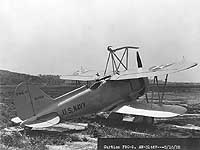 |
|
Photo #: NH 98100 Curtiss F9C-2 "Sparrowhawk" fighter (Bureau # 9056) Photographed on 16 May 1932, probably at Naval Air Station Anacostia, D.C. Official U.S. Navy Photograph, from the Collections of the Naval History and Heritage Command. Online Image: 85KB; 740 x 525 pixels |
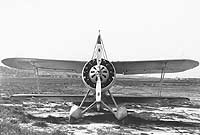 |
|
Photo #: 80-G-432806 Curtiss F9C-2 "Sparrowhawk" fighter (Bureau # 9056) Parked at an airfield, circa 1933-1935. This plane is part of the USS Macon (ZRS-5) heavier-than-air group, whose insignia is painted below the cockpit. Official U.S. Navy Photograph, now in the collections of the National Archives. Online Image: 65KB; 740 x 565 pixels Reproductions of this image may also be available through the National Archives photographic reproduction system. |
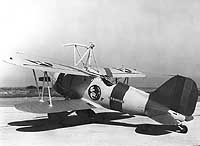 |
|
Photo #: NH 77428 Curtiss F9C-2 "Sparrowhawk" fighter (Bureau # 9058), piloted by Lieutenant Harold B. "Min" Miller Flying over Naval Air Station Moffett Field, California, in 1934. This plane was then assigned to USS Macon (ZRS-5). Courtesy of Harold B. Miller, 1973. U.S. Naval History and Heritage Command Photograph. Online Image: 105KB; 740 x 585 pixels |
 |
|
Photo #: NH 71617 Curtiss F9C-2 "Sparrowhawk" fighters (including Bureau #s 9055, at left, and 9057, in lower right) Flying in a "V" formation, circa 1933-1935. These planes are part of the heavier-than-air group of USS Macon (ZRS-5). U.S. Naval History and Heritage Command Photograph. Online Image: 96KB; 740 x 605 pixels |
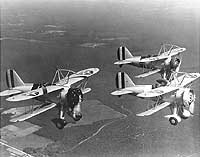 |
|
Photo #: NH 77426 Curtiss F9C-2 "Sparrowhawk" fighters (including, from left to right: Bureau #s 9058, 9060, and 9061) Flying in formation over Naval Air Station Moffett Field, California, in 1934. These planes are part of the heavier-than-air group of USS Macon (ZRS-5). Courtesy of Harold B. Miller, 1973. U.S. Naval History and Heritage Command Photograph. Online Image: 128KB; 740 x 580 pixels |
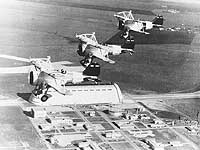 |
|
Photo #: NH 77429 Lieutenant Harold B. "Min" Miller, USN With his Curtiss F9C-2 "Sparrowhawk" fighter, while visiting his hometown, Newton, Iowa, while en route from Lakehurst, New Jersey, to Moffett Field, California, in October 1933. The man in the plane's cockpit is Aviation Machinist's Mate 3rd Class Glowacki. Both men, and the aircraft, were part of the USS Macon (ZRS-5) heavier-than-air group. Macon was also en route to Moffett Field, but her "Sparrowhawks" were making the trip independently. Courtesy of Harold B. Miller, 1973. U.S. Naval History and Heritage Command Photograph. Online Image: 95KB; 740 x 495 pixels |
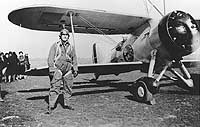 |
|
Photo #: NH 77430 USS Akron (ZRS-4) Pilots of the airship's Heavier-Than-Air unit pose in front of one of their Curtiss F9C-2 "Sparrowhawk" fighters, at Naval Air Station Lakehurst, New Jersey, in 1933 sometime after Akron's loss. Present are (left to right): Lieutenant (Junior Grade) Robert W. Lawson, Lieutenant Harold B. Miller, Lieutenant Frederick M. Trapnell, Lieutenant Howard L. Young, and Lieutenant (Junior Grade) Frederick N. Kivette. Courtesy of Harold B. Miller, 1973. U.S. Naval History and Heritage Command Photograph. Online Image: 97KB; 740 x 590 pixels |
 |
|
Photo #: NH 80770 Curtiss F9C-2 "Sparrowhawk" fighter (Bureau # 9057) Annotated three-view drawing by Willis L. Nye, prepared for the American Aviation Historical Society, 3 March 1958. Courtesy of Richard K. Smith, author of the book "The Airships Akron & Macon", 1974. U.S. Naval History and Heritage Command Photograph. Online Image: 297KB; 950 x 1225 pixels |
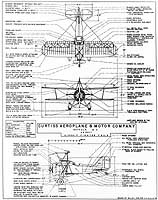 |
For additional views of F9C aircraft, see:
NOTES:
| If you want higher resolution reproductions than the digital images presented here, see: "How to Obtain Photographic Reproductions." |
Page made 13 October 2002
Coding updated 7 May 2009